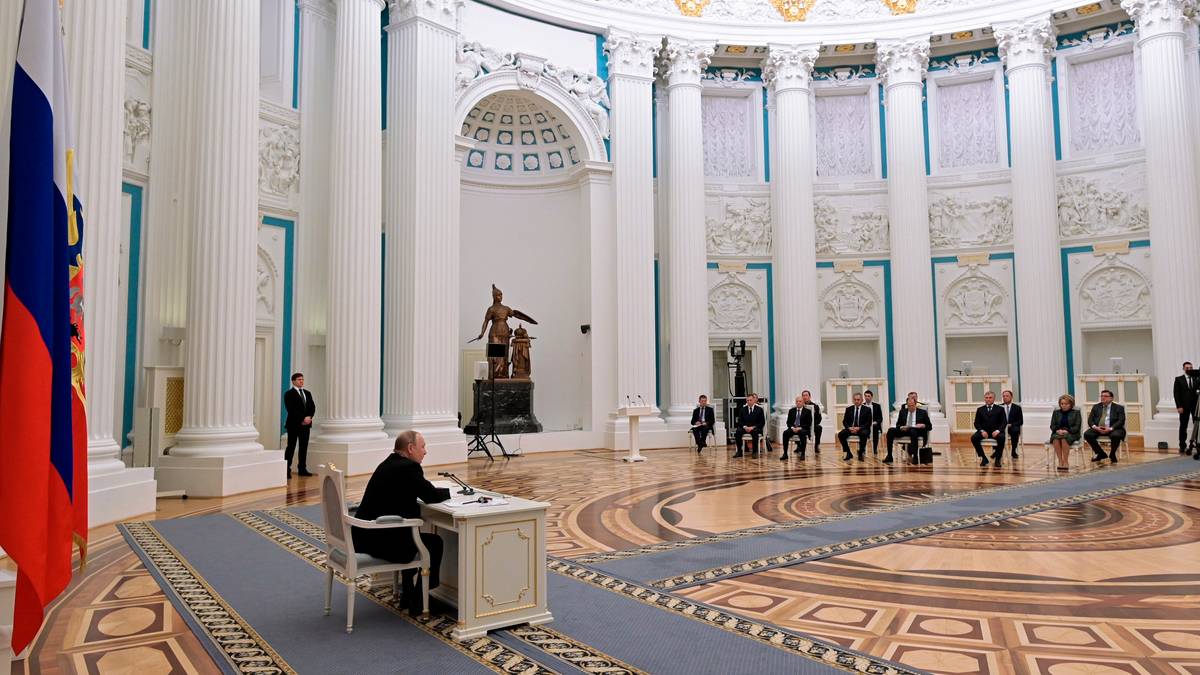It was a unique piece of political theater in the Kremlin yesterday:
One by one, Putin’s most powerful men, and one woman, had to tell him that Russia should recognize the two breakaway areas in eastern Ukraine on live television.
Putin listened as he sat at a large white desk in the center of the room. It almost looked like he was bored at times, before he told himself to make the decision.
If anyone was wondering where the power lay in Russia, the TV show should remove all doubt: It lies with one man.
The message was not to be misunderstood
A few hours later, Russian television broadcast a speech in which Putin explained why he had decided to recognize the breakaway areas of Luhansk and Donetsk. As usual, he blamed much of the conflict on the United States and the West.
He also took the time to explain that Ukraine was not really a real state, but a political entity created by Russian communists led by the first leader of the Soviet Union, Vladimir Lenin.
Ukrainians and professional historians strongly disagree with this simplified, if not falsified, storytelling. But the message of Putin’s aggressive speech was not to be misunderstood: Ukraine should really be part of Russia.
On the scrap heap of history
It is worth recalling that Ukraine became independent after an overwhelming majority referendum in 1991. In 1994, Russia guaranteed Ukraine’s territorial integrity in exchange for giving up its nuclear weapons. Ukraine was then the world’s third largest nuclear power.
After the war in 2014, Russia negotiated with Ukraine on an agreement where the breakaway regions would have a certain degree of autonomy, the so-called Minsk agreements. With yesterday’s recognition, these agreements belong on the scrap heap of history.
The Ukrainian authorities have not liked these agreements either, but it was Russia that took responsibility for breaking the illusion. It otherwise goes against what both President Putin and his foreign minister Sergei Lavrov have so far said should be part of the solution.
Basis for greater and longer conflict
The question is where the road goes forward. Russia has said it will send troops into the area. In his speech, Putin made it clear that it is now up to Ukraine to ensure that this does not develop further, and that all responsibility in that case lies with the authorities in Kyiv.
It will thus be easy for the Russians to find an excuse to start a war inside Ukraine, if they so wish.
The build-up of forces around Ukraine means that Russia has every military opportunity to go further than just moving into areas that the Russians control through the local rebel forces.
Putin’s speech provided an ideological basis for a larger and longer conflict. It may well be that the Russians choose to wait a bit in the first place. But after yesterday, it feels more like a question of time before the conflict will expand, than whether it will happen.
Old and dangerous dynamics
Europe and the United States must now find an answer to Russia’s latest move. They can choose to look at it a little so as not to use all the sanction options at once.
A sign pointing in the opposite direction is that Germany has frozen cooperation with Russia on the important gas pipeline Nord Stream 2. Such reactions are likely to be included in the assessment when Vladimir Putin will decide how to proceed. In any case, his speech shows that he thinks in a long historical perspective, and that he wants greater control over Ukraine.
This is not the first time Russia has intervened militarily and recognized territories in a neighboring country. They have already invaded parts of Ukraine and taken the Crimean peninsula. They’re been at war with Georgia. What is different now is that Russia operates in open land and not under the guise of local groups or soldiers without uniforms.
With this, Europe is back in an old and dangerous dynamic.
History should have taught us to be vigilant when powerful heads of state use history as an argument in conflict with a neighboring country. Especially when the country that threatens is one of the world’s leading nuclear powers.
–


:quality(70)/cloudfront-us-east-1.images.arcpublishing.com/metroworldnews/4NF5K3DFLFB4DIRBM36DGW2DWU.jpg)